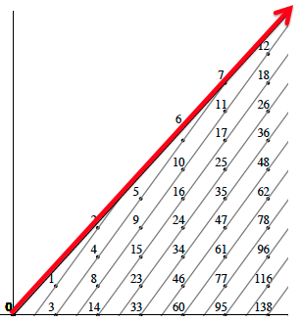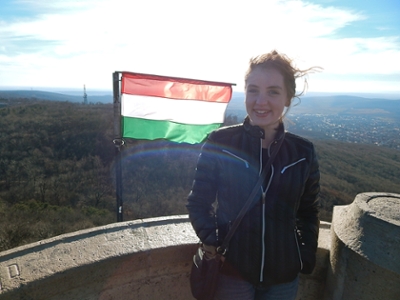
IRIS login | Reed College home Volume 96, No. 2: June 2017
How to Conquer the Number Plane

An ascending 1-stair packing polynomial, which assigns an integer to each co-ordinate in the sector of the plane that has been cordoned off by the hobgoblin's velvet cord (in this example, the hobgoblin chose the sector bounded by a line with slope 8/5).
Imagine dashing into a vast, Borgesian concert hall just before the curtain rises. There’s an infinite number of guests and an infinite number of seats, neatly arranged in rows and columns. Unfortunately, a mischievous hobgoblin has roped off a section of the auditorium with a velvet cord, putting some seats out of commission. How do you, Guest N, figure out where to sit?
Okay, it’s a far-fetched scenario, but math major Maddie Brandt ’15 is the first person in history to solve it in her paper “Quadratic Packing Polynomials On Sectors Of R2,” which she will present at a national conference in January.
The problem of assigning guests to seats is directly related to the problem of mapping the non-negative integers (those friendly, deceptively familiar objects such as 0,1,2,3, and their ilk) onto the co-ordinate plane (defined by pairs of integers such (0,0), (0,1), (0,2), etc.—think of the game of battleships). How do you map the integers to the co-ordinate pairs in such a way that you count all the pairs one after another, without skipping any?
Reed students encounter this problem in Math 321, Real Analysis, and solve it with a packing polynomial—a formula that assigns (x,y) to a particular integer N. (The standard solution, proved by Fueter and Pólya in 1923, is N = (x+y)^2/2 + (x+3y)/2, if you’re curious.)
In Maddie’s paper, the problem is complicated by the introduction of a rational sector—the hobgoblin’s velvet cord. (She solved it by constructing K-stair polynomials.)
Maddie came to Reed from St. Louis, Missouri., intending to major in physics. Then she took Math 332, Abstract Algebra, from Prof. Rao Potluri [mathematics 1973–2014]. “I really loved that class,” she says. “It was like opening a doorway into a whole world. I got a taste for higher mathematics and I wanted more.”
The Reed math department is notorious for its emphasis on understanding the why as well as the how. This approach can be challenging for students who just want to solve formulas, she says, but it has proven invaluable as she pursues mathematical ideas long beyond the reach of websites and textbooks.
For her senior thesis, which she is writing with Prof. Angélica Osorno [mathematics 2013–, Maddie is working on the Erdös-Ko-Rado theorem, an influential idea in the field of combinatorics, which bears on the following conundrum. Suppose that the world has n languages, and you wish to assemble a group of diplomats such that each diplomat in the group speaks exactly k languages, and any two diplomats speak a common language. How many diplomats do you need?
Maddie is trying to find a new way to prove the EKR theorem by deriving it from the Baranyai theorem, named for Hungarian mathematician (and musician) Zsolt Baranyai. So far, she’s discovered that a conjecture based on the Baranyai theorem, known as the “wreath conjecture,” does in fact lead to EKR. Proving the wreath conjecture, however, will be a major undertaking.
In addition to her mathematical pursuits, Maddie has worked at the Reed reactor, tutored in the math help center, and taken classes in ceramics. Last year she went to Budapest to study math for a semester abroad and took a crash course in Hungarian (an experience she describes as “linguistic induction”).
Her paper on packing polynomials won honorable mention for the Alice T. Schafer Prize for Undergraduate Women in Mathematics from the Association for Women in Mathematics, and she has been invited to present her findings at the Joint Mathematics Meetings in San Antonio, Texas, in January.
Tags: math, infinity, polynomial



LATEST COMMENTS
steve-jobs-1976 I knew Steve Jobs when he was on the second floor of Quincy. (Fall...
Utnapishtim - 2 weeks ago
Prof. Mason Drukman [political science 1964–70] This is gold, pure gold. God bless, Prof. Drukman.
puredog - 1 month ago
virginia-davis-1965 Such a good friend & compatriot in the day of Satyricon...
czarchasm - 4 months ago
John Peara Baba 1990 John died of a broken heart from losing his mom and then his...
kodachrome - 7 months ago
Carol Sawyer 1962 Who wrote this obit? I'm writing something about Carol Sawyer...
MsLaurie Pepper - 8 months ago
William W. Wissman MAT 1969 ...and THREE sisters. Sabra, the oldest, Mary, the middle, and...
riclf - 10 months ago